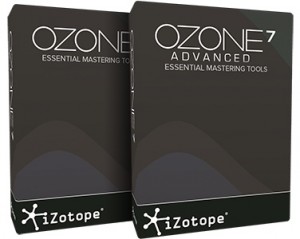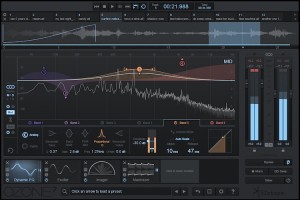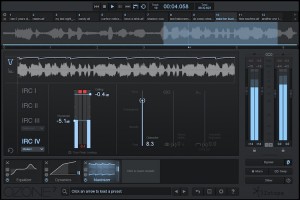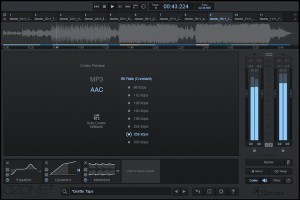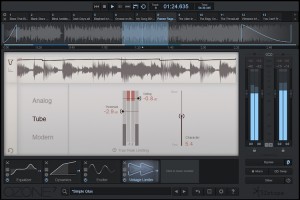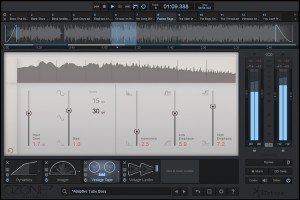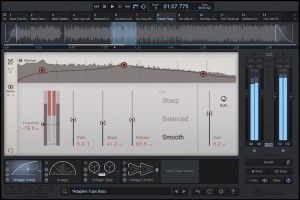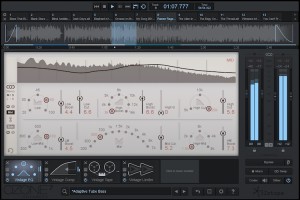New Software Review: iZotope’s Ozone 7 & Ozone 7 Advanced Mastering Suite
Can iZotope’s Ozone replace the warmth and life of analog mastering hardware? In the past, it never even tried to, instead offering a decidedly next-generation take on the mastering engineer’s toolkit. But with Ozone 7, iZotope has added emulations of some very classic hardware to go along with the more forward-looking updates we’ve come to expect from the brand.
As with previous versions, Ozone 7 allows you to customize your own mix bus and mastering with a variety of powerful and flexible modules. This release continues iZotope’s tradition of providing a slew of useful tools under one hood, with an excellent interface that’s easy to navigate.
The biggest changes to the standard version of Ozone 7 can be found in the updates to the Dynamic EQ and the Maximizer. The Ozone 7 Advanced Suite however, adds a full arsenal of new tools: The “Vintage” family of processors, including a Vintage Tape, Vintage EQ, Vintage Limiter and Vintage Compressor. Plus, mastering engineer and Grammy award nominee Greg Calbi lends his seasoned ears to creating a free set of presets for both versions, including “High Detail Wide”, “Midrange”, and “General Clarity.”
Ozone 7 can also be used on its own as a standalone mastering DAW, that supports third-party AU & VST plug-ins as well in your Ozone mastering chain. With the Ozone standalone App, you can audition your processing in real time, trim the tops and tails of your masters and even export files as MP3 and/or AAC.
To give each of these new features a test, I gave them a whirl in Pro Tools, Logic and as a plug-in a specialized mastering DAW, Pyramix.
Dynamic EQ
The new Dynamic EQ’s streamlined layout is eye-grabbing: The gun metal black backdrop and sky blue accents make it easy to spend time with. New to Ozone 7, there are now six, reverse-rainbow-colored EQ bands, adding two more bands compared to the Dynamic EQ’s first iteration in Ozone 6.
While standard EQs can only provide a static boost or cut regardless of what the music is doing, the Dynamic EQ adjusts the amount of boost or cut based on user-definable parameters. This makes it easier to have a more subtle EQ that moves with the music, only taming down problem frequencies when they start to become a problem, or only boosting specific areas when they are lacking.
Similarly, if a performance ranges from mellow to explosive sections, with the right settings your EQ gain could be greater for the quieter parts and less significant for the more intense parts (unless of course, you want the inverse) thus creating a smoother, less jarring equalization.
IRC IV Maximizer
More maximizing for the most maximizingest.
The addition of the new IRC IV (Intelligent Release Control) algorithm for the Ozone Maximizer may be worth the upgrade alone for many users alone. With this algorithm, it is possible to achieve the most transparent and “Intelligent” limiting Ozone has to offer.
IRC IV automatically detects which frequency bands would contribute most to clipping, and then gently reduces their level before hitting the limiter, so that the limiter doesn’t have to work as hard.
There are three settings in this mode, each with a subtly different flavor:
“Classic” is based off previous Ozone 7 IRC algorithms, offering a tried and true maximization; “Modern” offers an even clearer, more defined limiting; and “Transient” is perhaps the most aggressive-sounding, but also the clearest and most transient-preserving of the three.
Codec
Another new feature available in both Standard and Advanced versions of Ozone is the Codec Preview. This allows you hear how your audio would sound once it is digitally converted to MP3 or AAC.
The preview resolutions available range from 96kbps to 320kbps. The “Solo Codec Artifact” performs exactly as described, allowing you to audition the results of what is being removed from the mix by lossy compression.
In order to use this function properly, you must use it at the very end of the chain. You can also export your work in a variety of digital formats such as MP3 and AAC and even add metadata such as track name, artist, album title before each exporting.
“It’s Vintage”
Previous versions of Ozone have been equally celebrated and criticized for their unabashedly “digital” sound. With Ozone 7, iZotope has incorporated four new modules that emulate vintage audio hardware: A vintage limiter, 2-track tape machine, EQ and compressor.
The design for each of these modules is basic—in a good way—appearing solid, with earthy colors. The GUIs are resolutely non-flashy (as they should be) and each control you need is only a mouse-click away, incorporated right into the main Ozone interface.
Vintage Limiter
Just a touch of limiter…a little bit.
A little goes a long way with this gem of a limiter, based loosely on the classic Fairchild 670 tube limiter. It glues the mix together and can add a little extra jazz or smack it to oblivion and level out a wonky mix.
The controls on the Vintage Limiter are almost identical to the ones on the Maximizer: Gain Reduction, Threshold, Character, and it even carries over the True Peak Limiting Function from its more contemporary-sounding cousin.
IRC (Intelligent Release Control) is at work under the hood of all three of its modes Analog, Tube, and Modern, and each of these modes has its own character:
“Analog”, the warmest of the three, is meant for limiting individual tracks or a mix that you want thickened up.
“Tube” mode, originally found in the Maximizer, has moved to the Vintage Limiter. It is backwards compatible with Ozone 6.1’s Maximizer Tube mode, so saved presets will open in Ozone 7’s Vintage Limiter Tube mode. Tube can be used for when you want to warm something up but still need it to maintain some clarity and excitement (more hi-fi).
“Modern” is more defined-sounding than tube, but still maintains the fullness that comes with an analog tube limiter.
Vintage Tape
Using the Vintage Tape module gives your music a little more color. Whether you want subtle analog flavor or rich tape compression and saturation, this module can do it all.
It is based on the character of the Studer A810 2-track tape machine. Simply placing it across your mix can help enhance the depth and width, achieving immediate results.
Choose between two different tape speeds: 15 and 30 (inches per second). 15 ips offers a vibey sound and can sweeten up a lifeless mix, while 30 ips adds clarity to the mid and high ends while still adding a subtle dose of tape “phatness”.
One cool trick is to try is to gently increase the input drive of the vintage tape to add a lil’ bit of extra juice (and overall volume.)
Vintage Compressor
The Vintage Compressor is a single-band, feedback compressor with all the usual controls: attack, release, gain, ratio and threshold. Automatic gain compensation helps make up for what’s lost from compression.
The sidechain has three editable detection filters: high-pass, mid-peak and high-shelf. However, the detection filter stops at 40 Hz and so you cannot fully turn this function off. This cutoff is based on vintage feedback compressors, as they were not designed to handle and compress the super low frequencies that today’s modern compressors can.
It has three modes: “Sharp”, which offers the most transparent compression; ”Smooth” which provides the most “compressed’ sound and offers the most squeeze; and “Balanced”, which is exactly as it says and offers a nice middle-ground of dynamic and transient control.
Vintage EQ
The Vintage EQ emulates two classic Pultec equalizers from the 1950’s: The Pultec EQP-1A and the MEQ-5. The EQP-1A focuses on the high and low frequencies and the MEQ-5 on the midrange.
While not as surgical as the standard Ozone EQ, the vintage EQ offers a smoother, vibe-ier color. By simply putting it on your master bus or tracks, you will notice immediately that it does wonderful tube-y things, effectively recreating the soft-limiting exhibited by a vintage valve EQ.
Ozone has added a new frequency to the EQP-1A section at 45Hz, which is not seen on the original hardware. As with all other Ozone modules, the EQ can be used not only in stereo but in L/R and M/S operation, which opens the door to many sound shaping possibilities.
To be critical
Ozone 7, and its presets, should not be thought of as a one size fits all solution. Over-doing and over-using it is a common pitfall, and if you fall into this trap, the results can sometimes worse than not doing anything at all. For some users, Ozone should probably come with a warning label advising them not to go directly to the presets as a one-stop-drop-shop for improving the sound of their mixes. They can be a useful starting point, but that’s about as far as it goes.
I’ve seen first-hand at a mastering studio just how much trouble this program can cause when overused at the mix stage. A large percentage of users seem to slap it on their master bus with one of the presets, instantaneously making their mix sound louder, and therefore “better” in a quick sip test. They are glamoured by the results, bounce the mix and use this as a listening reference, sometimes even sending their over-compressed mix to the mastering engineer, expecting them to take it even further in level and hype. This gives the wrong expectations for what good mastering is really about, and tests the patience of your mastering engineer.
Speaking of presets, I would prefer the factory default preset for Ozone 7 to be a blank slate. I found it somewhat cumbersome to have to turn off the modules I don’t want to use every time I open up the plugin. Even if you do want to use all of the default modules eventually, it usually makes sense to start off by adjusting one module at a time as you build your processing chain step-by-step.
When I brought this critique to iZotope, I found out that they had recently introduced a new “preset default” function in version 6.1, allowing you to set the default for yourself without too much difficulty. This little-known feature is definitely a step in the right direction.
As a standalone application, it seems Ozone is still a little clunky, and it crashed on me a few times. Since it’s still so new at this point, I would much rather use a dedicated mastering DAW instead for professional work.
It’s also worth noting that Ozone can be a CPU monster. Even the Maximizer alone is incredibly processor-intensive, especially when using IRC III and IRC IV modes.
Keeping up with all the updates iZotope has to offer can often be a small job in itself, and while updating and frequently improving Ozone they actually took a feature away that has been missed since Ozone 5: the “amount slider”. This helpful knob used to let you blend in a desired amount of the effected signal, giving much more flexibility and control.
Conclusion
The physical modeling in Ozone has come very far since the beginning. While not identical to the classic gear they were inspired by, the Vintage modules are pretty close and offer a somewhat convincing “analog” flavor.
The real hardware units that the plug-ins emulates are very expensive, exclusive and powerful. The fact that iZotope has created these plug-ins at an affordable price truly helps all users, no matter what stage they are at, and gives the already-flexible Ozone suite even more useful options than before.
iZotope offers a free 10 day trail of Ozone 7, so check it out for yourself and tell us what you think in the comments below!
Ozone 7 Operates with:
Windows: 7, 8, and 10 Mac: OS X 10.8–10.11 (Intel only)
Plug-in formats:
Pro Tools 10-12 (RTAS, AudioSuite, 64-bit AAX), VST 2, VST 3, Logic Pro X, Ableton Live
Price:
iZotope Ozone 7 Mastering Suite $249
iZotope Ozone 7 Mastering Suite- Upgrade from Ozone $99
iZotope Ozone 7 Mastering Suite- Upgrade from Ozone $199
Or purchase Ozone 7 Advanced in the iZotope music production bundle along with the Alloy 2, Nectar 2 Production Suite, Trash 2 (Plus Expansions) and Insight for $599
Please note: When you buy products through links on this page, we may earn an affiliate commission.







